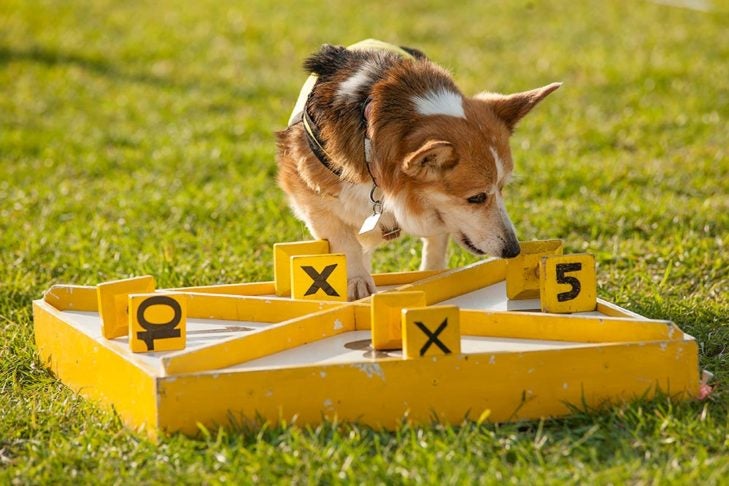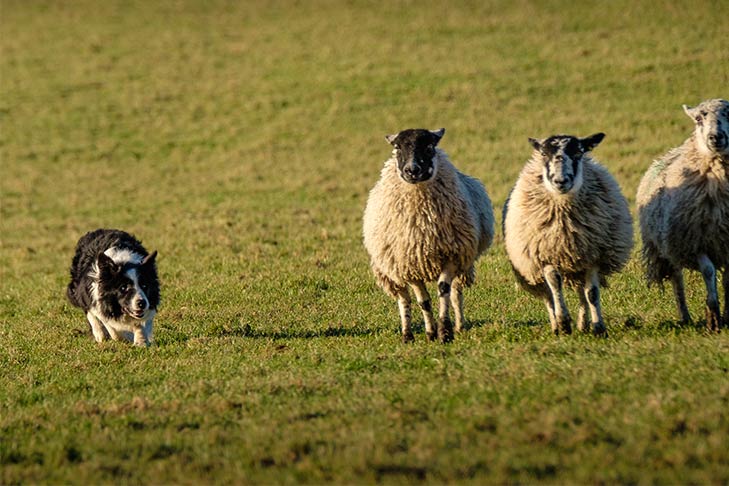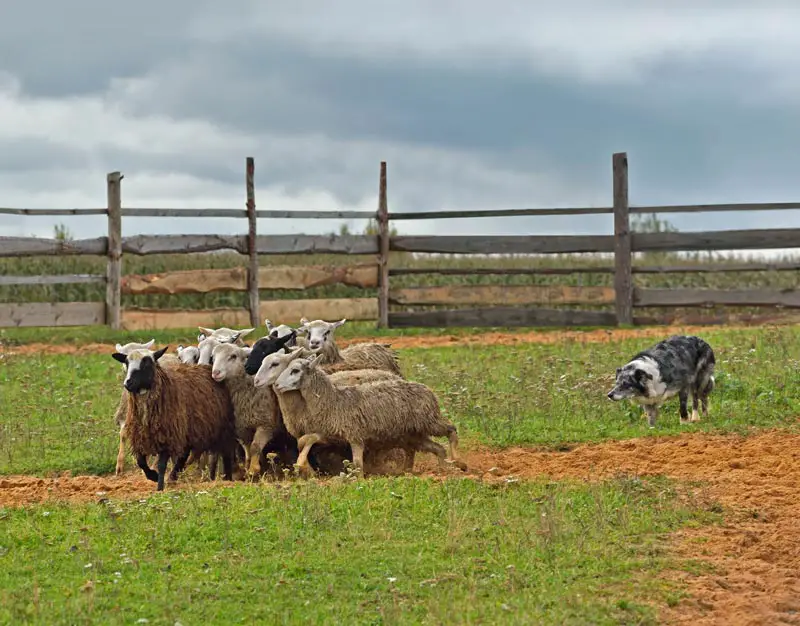Preventing Herding Behaviors From Becoming a Problem
Although herding has a very practical purpose for working dogs needing to move livestock, that same instinct can kick in inside the home. Dogs will express their herding drive with whatever is available, including other pets, kids, and even you. Since these hardwired instincts are triggered by movement, herding is usually not something your dog is doing just to get attention or to deliberately misbehave.
Dogs aren’t confused about whether or not kids are sheep. And it’s doubtful your pant legs look like cow hooves. Dogs are simply doing what comes naturally when movement catches their eye. Of course, you can’t solve the problem by never moving around your dog. But, stay aware of reactions to the problem. For example, if your kids run away from the dog when the dog nips their feet, that will only trigger the behavior to continue.
Prevent your dog from practicing unacceptable herding as much as possible while you teach basic obedience. Teaching training behaviors like “Watch Me” and “Leave It” will help you redirect your dog’s attention when moving objects are nearby.
It’s also helpful to teach your dog self-control. For example, fetch and tug-of-war are great games to play with your dog. But before you throw the ball or offer the tug toy, ask your dog to do a calm behavior like lying down or sitting. This not only reinforces good manners. It also teaches your dog to remain calm in the face of things that trigger that predatory instinct.
Giving your dog’s mind and body a proper workout is another essential. Herding breeds were developed to work hard all day long. They are incredibly smart and will find their own fun if you don’t give them something to do. Make sure you are providing enough physical exercise for your dog. Lastly, consider games that challenge your dog’s brain like hide and seek or other puzzle-solving activities.

It’s unrealistic to expect your dog to never express any herding instincts. Instead, consider finding an acceptable outlet for channeling those drives. The obvious outlet is the sport of AKC Herding. If having your dog herd actual animals isn’t an option, you might want to consider Treibball (pronounced Tribe Ball). Treibball involves “herding” large fitness balls around a playing field or indoor arena. This may be an especially intriguing option for city dogs.
Other dog sports can also help meet your dog’s instinctive needs. Flyball is fantastic for dogs obsessed with chasing tennis balls. This relay race style sport allows dogs to tap into their drives as they run over hurdles, use their paws to push on a spring-loaded pad to release a tennis ball, and catch that ball before running back to their handler. Disc dog is another great option for fetch-loving dogs that uses a flying disc for its games. Finally, AKC Agility is a wonderful way to engage your dog’s brain, provide physical exercise, and build teamwork as you direct your dog over an obstacle course of tunnels, jumps, and weave poles.
Need some help training your dog? While you may not be able to attend in-person training classes during COVID-19, we are here to help you virtually through AKC GoodDog! Helpline. This live telephone service connects you with a professional trainer who will offer unlimited, individualized advice on everything from behavioral issues to CGC prep to getting started in dog sports. https://www.akc.org/wp-admin/admin-ajax.php Get Your Free AKC eBook
Clubs Offering:
|
If you’re searching for an intelligent, energetic, and hard-working dog, look no further than a herding breed. But, don’t be surprised if some other characteristics are part of the package too. As the name suggests, herding breeds were developed to gather, herd, and protect livestock such as sheep or cattle.
That shared heritage means they all have the instinctive skill and drive to control the movement of other animals. To a herding dog, however, “other animals” means the humans in the house, too.
For thousands of years, people around the world have relied on dogs to move other animals from pasture to pasture or back to the barn. If you’ve ever seen dogs herding sheep or cattle, you know how impressive their abilities can be. Those abilities are not trained into the dog, but rather come instinctually.
A dog’s wolf ancestors were predators, and as such, they were hardwired with a set of behaviors essential to catching and killing prey. The full sequence of actions includes:
Depending on a breed’s original purpose, some or more of that instinctive predatory sequence may remain. For example, terriers were developed to pursue animals like foxes and badgers that threatened livestock. These dogs can have quite strong predatory instincts all the way through the sequence.
Conversely, toy dogs like the Japanese Chin were developed as human companions, so you can expect most to have weaker predatory instincts. But, as the dog toy industry has proven, almost every dog has some predator left inside, even if it only comes out when a squeaky toy is thrown across the living room.
When it comes to herding breeds, the early parts of the predatory sequence are exhibited more strongly than the others. Specifically, the search, stalk, and chase. Through years of breeding, the later parts of the sequence have been significantly subdued. However, even that varies within the herding group.

For example, the Border Collie is renowned for the ability to “give eye,” or stare down sheep to control their movement. They might occasionally nip a stubborn sheep, but that’s not usually part of their repertoire. Their predatory sequence tends to stop at chase. On the other hand, the Australian Cattle Dog is also known as the Blue Heeler because these dogs nip the heels of cattle as part of their herding strategy. For Heelers, the predatory sequence stops at grab/bite.
Should Herding Behavior Be Encouraged?
That’s a difficult question to answer. For all the problems and disruption that herding behaviors may cause in your home, trying to eliminate said traits would likely result in your dog being lethargic, miserable, and morose.
Instead of eliminating them, try to work with them. Chances are, you’re unlikely to outsmart thousands of years of evolution and create an entirely docile dog. Rather, allowing your dog to express itself once in a while in a controlled manner is a better approach.
However, if you find that your dog’s herding behavior is causing a problem, it’s time to be direct with your dog. Showing signs of laughter or enjoyment may be misinterpreted as your dog thinking you’re playing a game, so it’s vital to be assertive in the face of this unruly behavior.

To get your herding dog fully trained, it’s important to teach it some herding commands. For example, ‘’come-by’’ tells the dog to move clockwise around the sheep, whereas ‘’away!’’ means to move it in the opposite direction.
The phrase ‘’lie down’’ should be directed if you wish to cease your dog’s movement. As your dog’s training develops, this command can go on to have subsequent meanings like ‘slow down,’ ‘pause,’ or its literal meaning of lying down.
If your dog does indeed lie down on command, then the phrase ‘stand’ can be implemented to get it to rise again. ‘’That’ll do’’ is a famous saying that tells the dog that the work is complete and they need to return to you as soon as possible.
Dogs are intelligent animals, and you can teach them to follow a whole list of herding commands. This must be done when the dog is still extremely young and not set in its ways. Dogs may be smart, but they’re also famously stubborn. As the saying goes, you can’t’ teach an old dog new tricks.
Try not to overload your dog’s brain by teaching it too many things, either. There are only so many things your dog can remember, so try to break down its learning piece by piece. This will help it retain information, and it will also allow it to absorb its command fully. Aim for quality of learning rather than quantity of words taught.